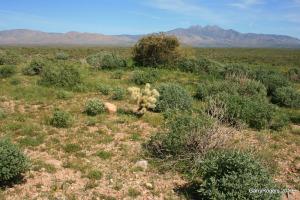Post-Fire Recovery in the Arizona Upland of the Sonoran Desert

Fire-prone invasive plants fueled fires that converted this formerly diverse Sonoran Desert landscape of small trees and tall Saguaro cactus into an impoverished shrubland.
By Garry Rogers.
Following fires in 1974, Jeff Steele and I used repeated observations of permanent plots and transects to measure fire-related adaptive responses of perennial plant species and communities. We found that positive adaptations that would allow recovery after burning were common, but they were weak. Most plants died. Return of the original plant community was taking place very slowly. We projected that several decades would be required for full recovery.
After we published the initial results, both sites burned again. We repeated our observations of the plots and transects several times. In 2008, I reported that 22 years after the second fires, recovery had not occurred (Turner et al. 2010). Only fast-growing members of the original plant community had returned, and large numbers of fire-prone invasive alien plants occupied both sites. Casual observations in 2015 indicated that conditions had not improved. It appears unlikely that the original diverse vegetation dominated by tall Saguaro Cacti and round green Paloverde trees will ever return.
Perhaps no fire in the Sonoran Desert has been natural since the introduction and spread of exotic annuals. Both frequency and intensity may have increased.
- Citation: Rogers, Garry, and Jeff Steele. 1981. Sonoran desert fire ecology: Adaptive strategies of perennial plant species. Pages 15-19 in U. S. Forest Service, General Technical Report RM81: 1519. Link to PDF copy of paper.
- Reference: Tuner, Raymond M., Robert H. Webb, Todd C. Esque. 2010. Repeat photography and low elevation fire responses in the southwestern United States. Pages 223-244 in R. H. Webb, D. E. Boyer, and R. M. Turner, eds. Repeat photography methods and applications in the natural sciences. Island Press, Washington, DC. 530 p.

